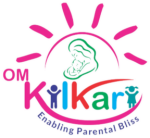Introduction
For parents of nonverbal children, communication can feel like an overwhelming challenge. Watching your child struggle to express their basic needs, emotions, or thoughts is heart-wrenching. But there is hope—and it comes in the form of AAC (Augmentative and Alternative Communication). At Kilkari Child Development Centre, we empower every child with the tools and support they need to communicate effectively, regardless of speech limitations.
What is AAC?
AAC stands for Augmentative and Alternative Communication. It refers to all forms of communication other than oral speech used to express thoughts, needs, wants, and ideas. AAC can be used temporarily or long-term, depending on the child’s needs.
There are two main types of AAC:
- Unaided AAC: Uses the child’s body to communicate—like gestures, facial expressions, body language, and sign language.
- Aided AAC: Involves tools or equipment ranging from simple picture boards to sophisticated speech-generating devices.
Why is AAC Important for Nonverbal Children?
Nonverbal children, whether due to autism spectrum disorder (ASD), cerebral palsy, Down syndrome, or developmental delays, may struggle to develop verbal language. AAC provides a voice for these children—literally and metaphorically.
Key benefits of AAC include:
- Improved communication – Children can express wants, needs, thoughts, and feelings.
- Reduced frustration – Understanding leads to fewer emotional outbursts.
- Enhanced social interaction – AAC helps children connect with peers and adults.
- Boost in confidence and independence – Children feel heard and understood.
Common AAC Tools and Techniques
AAC tools are as unique as the children who use them. Here are some commonly used AAC systems:
- Picture Exchange Communication System (PECS): Children hand over a picture of what they want to communicate.
- Communication Boards or Books: Boards with symbols or words that children can point to.
- Speech-Generating Devices (SGDs): These devices “speak” when a child presses buttons or symbols.
- Apps and Tablets: AAC apps like Proloquo2Go, Avaz, or CoughDrop turn tablets into communication tools.
- Sign Language: A valuable form of unaided AAC that many children use effectively.
When Should AAC Be Introduced
It’s a myth that AAC should be delayed until a child is older or until it’s clear they won’t speak. In fact, introducing AAC early supports language development and does not stop a child from learning to speak—often, it helps accelerate speech!
At Kilkari Child Development Centre, our speech-language pathologists and special educators recommend early intervention. The earlier a child receives AAC support, the better their chances for improved communication and social engagement.
How Kilkari Child Development Centre Supports AAC
At Kilkari, we understand that every child is unique—and so is their path to communication. Our personalized AAC programs include:
- Comprehensive assessments by speech and language therapists
- Selection of appropriate AAC tools based on the child’s ability and comfort
- Parent and caregiver training to ensure consistent AAC use at home
- Ongoing therapy and monitoring to track progress and make adjustments
We also integrate AAC into daily activities and play, making learning natural and fun for children.
Myths About AAC – Busted!
❌ Myth: “AAC is only for children who will never speak.”
✅ Fact: AAC supports all levels of communication. Many children who use AAC eventually develop speech or use both.
❌ Myth: “It’s too early to start AAC.”
✅ Fact: Children as young as 12 months can begin using simple AAC systems.
❌ Myth: “AAC will make my child lazy and not want to talk.”
✅ Fact: Research shows AAC encourages verbal development, not hinders it.
AAC Success Stories
At Kilkari, we’ve seen countless children flourish with AAC. Children who once had meltdowns out of frustration are now requesting toys, choosing activities, and even saying “I love you” through a button or gesture. These breakthroughs not only change the child’s life—they transform the entire family dynamic.
Conclusion: Giving Every Child a Voice
AAC is more than a communication tool—it’s a lifeline for nonverbal children. With the right support, every child can be heard, understood, and empowered.
If your child is struggling with speech or communication, don’t wait. Let the experts at Kilkari Child Development Centre help you explore AAC options tailored for your child’s growth and happiness.
Call to Action
📞 Contact Kilkari Child Development Centre today to schedule an assessment and find the best communication solution for your child.
🌐 Visit our website for more resources, success stories, and expert guidance.


